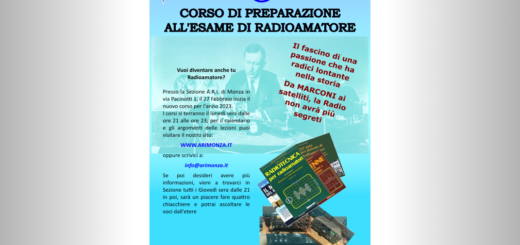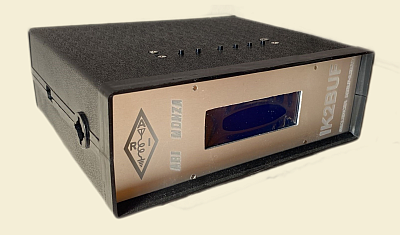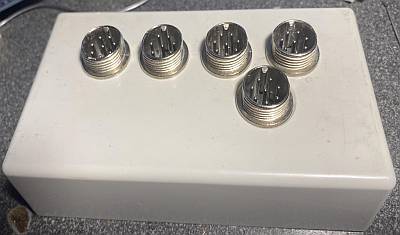20 Dicembre 2019
ARISS school contact planned for two schools in Bari, Italy
An ARISS school contact is planned for Luca Parmitano KF5KDP with Istituto Comprensivo “Japigia 1 – Verga”, Bari, Italy and Istituto Comprensivo “Caporizzi – Lucarelli”, Bari, Italy.
The event is scheduled Friday December 20, 2019 at approximately 12.35 UTC, which is 13.35 CEWT.
The contact will operated by IZ7RTN. Downlink signals will be audible in Europe.
The contact will be conducted in Italian.
This ARISS-Europe News Bulletin is circulated to 2758 subscribers.
School Information:
Istituto Comprensivo “Japigia 1 – Verga” Orione and Verga with pupils of age range 3 to 14 years. The pupils attending the school are 1125. Our school is well known and has distinguished itself for the advanced level of technology and projects. In the school there is modern equipment and space suitable for experiments/tests. Our Institute proposes different activities of educational robotics, simple and practical approach to the operation of robots, to the computer planning and the learning of technical subjects as science and mathematics with the purpose to stimulate the curiosity and the use of logic in students. Every year they participate successfully in national and regional competitions. Our Institute, besides participating every year to the week of the Code, transversally proposes the activity of coding to the disciplines studied with the purpose to develop in the learners the capacity of problem solving. Whereas during the week of the National Plan for the Digital School, the pupils of our Institute take part in a series of activities that involve the family and the personnel of the school experimenting different activities such as the digital sketch with Autocad, the digital comic strip, the 3D printer, the virtual classroom, small competitions of robotics to show the innovation that already exists in our school but that is in constant evolution. Moreover, in 2016 and 2017 pupils were involved in the international educational project “Mission X” concerning physical activity and proper nutrition that encourages children to train like a real astronaut. They have been able to understand the importance of healthy eating and regular physical activity, participating in an international challenge in which they did physical exercises and activities in the classroom, discovering what happens in space and how they can one day become protagonist of an international space adventure. A group of pupils has also participate in the STEM project “Cpu maker for pupils with a great mind”, activity that led to the realization of a microprocessor starting from the use of a Raspberry Pi, that is a calculator implemented by a single electronic card.
Istituto Comprensivo “Caporizzi – Lucarelli” The I.C. “Caporizzi _ Lucarelli” is a recent school institution that started its journey on September 1, 2016 following the unification between primary school “C. Collodi ” and secondary school ” Antonio Lucarelli ” in Acquaviva delle Fonti (Bari.. The school is composed of 7 school buildings and welcomes pupils aged from 3 to 14 years. The total number of pupils is 897 of which 4% are of foreign origin coming from European Union countries and non-EU countries. The number of teachers is 104. The school welcomes pupils with a family background diversified by the cultural and economic point of view. The school has got scientific, artistic, linguistic and technological laboratories and two gyms. There also is a laboratory devoted to atmospheric sciences. Meteorological model WRF (weather research and forecasting. is implemented and local meteorological forecast are realized.
Students First Names & Questions:
Istituto Comprensivo “Japigia 1 – Verga” & Istituto Comprensivo “Caporizzi – Lucarelli”
1. Andrea: In caso di colonizzazione dello spazio da parte dell’uomo, ci potranno andare tutti o solo i più ricchi? Esiste uno scudo spaziale capace di proteggerci da meteoriti e dalle radiazioni del sole?
2. Lidia: Sappiamo che l’uomo ritornerà a breve sulla luna, come si intende colonizzare il nostro satellite naturale?
3. Mario: La stampante 3D, progettata da Samantha Cristoforetti, a bordo della ISS, quali funzionalità ha?
4. Mattia: Le future missioni spaziali potranno essere supportate da aziende private?
5. Claudia: Nello spazio si usano solo combustibili fossili o anche energia nucleare?
6. Enrico: Ci sono programmi per realizzare nuovi sistemi di propulsione in modo da viaggiare nello spazio più velocemente?
7. Francesco: Con quali sistemi informatici funzionano le apparecchiature a bordo?
8. TBD: La scoperta dell’acqua su Marte cosa potrebbe rappresentare per i futuri esploratori spaziali?
9. Paola: A che punto è la robotica in Italia?
10. Angela: Le attività exstra veicolari possono avere degli effetti negativi sulla salute degli astronauti?
11. Mario: È stato lanciato il robot russo, denominato Fyodor, ma la sua avventura nello spazio è terminata perché le sue gambe si sono dimostrate d’intralcio. Si è già pensato ad un robot con una forma più adatta per svolgere determinati compiti?
12. Alessia: Ha notato evidenti variazioni nella dimensione dei ghiacciai e nell’avanzamento dei deserti tra la sua prima missione sulla ISS e la seconda?
13. TBD: Pensando a Dio io lo immagino al di là delle nuvole. Voi, quando siete nello spazio, sentite di più la sua presenza essendo più vicini a Lui? Gli chiedete mai il suo aiuto?
14. TBD: In quale modo l’Italia ha contribuito alla realizzazione dei moduli che compongono la ISS?
15. Roberta: A che punto sono le sperimentazioni relative alle malattie più gravi, come i tumori?
16. TBD: Come fanno gli astronauti a proteggersi dai raggi cosmici, soprattutto durante le missioni EVA?
17. Sara: Secondo le vostre esperienze è possibile costruire una base operativa sulla Luna per ulteriori scoperte?
18. TBD: Le batterie in uso sulla ISS hanno le stesse caratteristiche di quelle terrestri? Come vengono smaltite?
19. Nicola: La ISS può ulteriormente ampliarsi con altri moduli?
20. TBD: Cosa accadrà alla ISS quando non sarà più utilizzabile?
21. Luca: Di che cosa è fatto lo spazio?
22. TBD: E’ possibile osservare dalla ISS le calamità naturali che avvengono sulla Terra?
23. Jennifer: Quante radiazioni vengono assorbite da un astronauta sull’ ISS?
24. TBD: Quali sono i requisiti che devono avere gli astronauti per svolgere missioni all’esterno della ISS?
25. Graziana: Avete mai sbagliato qualcosa? Qual è la funzione della robotica nello spazio per il futuro?
26. TBD: C’è un modulo costruito interamente in Italia?
27. Francesco: Si è già pensato a una nuova Stazione Spaziale Internazionale, quando quella già esistente terminerà il periodo di funzionamento previsto? E quali modifiche tecnologiche si apporteranno?
28. TBD: A fine ottobre, in collaborazione con l’agenzia spaziale italiana ASI e quella europea ESA, è stato pubblicato un numero speciale del fumetto Nathan Never nel quale lei è tra i protagonisti. Che sensazioni le ha procurato questa circostanza?
Translation:
1. In the case of colonization of space by man, can all or only the richest go? Is there a space shield capable of protecting us from meteorites and sun radiation?
2. We know that humans are going back to the Moon soon; how are we going to colonize our natural satellite?
3. The 3D printer designed by Samantha Cristoforetti, on board the ISS, what features does it have?
4. Could it be that future space programs will be funded by private agencies?
5. Does space use only fossil fuels or even nuclear energy?
6. Are there any researches on finding new faster technologies to travel across the universe?
7. Which computer systems do the on-board equipment work with?
8. What would the discovery of water on Mars represent for future space explorers?
9. At what point is robotics in Italy?
10. Can the EVAs cause any negative effects on the health of astronauts?
11. The Russian robot, named Fyodor, has been launched, but his adventure in space is over because his legs have proved to be a hindrance. Have you already thought of a robot with a more suitable form to perform certain tasks?
12. Have you noticed any significant variation in the dimensions of the polar ice caps and deserts between your first and second mission on the ISS?
13. Thinking of God I imagine it beyond the clouds. Do you, when you are in space, feel his presence more, being closer to him? Do you ever ask for his help?
14. How has Italy contributed in developing the different modules composing the ISS?
15. At what point are the experiments related to the most serious diseases, such as tumors?
16. How do astronauts protect themselves from the cosmic rays, especially during the EVA missions?
17. According to your experiences, is it possible to build an operational base on the Moon for further discoveries?
18. Are the characteristics of the batteries used on the ISS the same of the ones on Earth? How are they disposed of?
19. Can the ISS further expand with other modules?
20. What will happen to the ISS when it won’t be used anymore?
21. What is space made of?
22. Can you observe natural disasters on the Earth from the ISS?
23.How many radiations are absorbed by an astronaut on the ISS?
24. What are the requisites for astronauts to take part to missions outside the ISS?
25. Have you ever done something wrong? What is the function of robotics in space for the future?
26. Is there a module completely produced in Italy?
27. Have you already thought of a new International Space Station, when the existing one will end the planned period of operation? And what technological changes will they make?
28. How does it feel to be one of the protagonists of the special number of the comic “Nathan Never”, published at the end of October in collaboration with ASI and ESA?
About ARISS:
Amateur Radio on the International Space Station (ARISS) is a cooperative venture of international amateur radio societies and the space agencies that support the International Space Station: NASA, Russian Space Agency, ESA, JAXA, and CSA. The US Center for the Advancement of Science in Space (CASIS) and the National Aeronautics and Space Administration (NASA) provide ARISS special support.
ARISS offers an opportunity for students to experience the excitement of Amateur Radio by talking directly with crewmembers on board the International Space Station. Teachers, parents and communities see, first hand, how Amateur Radio and crewmembers on ISS can energize youngsters’ interest in science, technology, and learning.
The primary goal of ARISS is to promote exploration of science, technology, engineering, and mathematics (STEM) topics by organizing scheduled contacts via amateur radio between crew members aboard the ISS and students in classrooms or informal education venues. With the help of experienced amateur radio volunteers, ISS crews speak directly with large audiences in a variety of public forums. Before and during these radio contacts, students, teachers, parents, and communities learn about space, space technologies, and amateur radio. For more information, see www.ariss.org, www.ariss-eu.organd www.amsat-on.be/hamtv-summary/.






